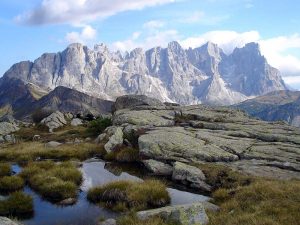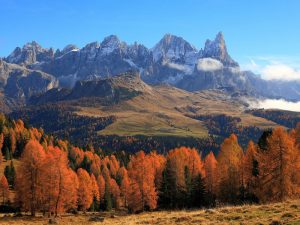 Il territorio del Parco Naturale Paneveggio Pale di San Martino si caratterizza, dal punto di vista geologico, per una elevata diversità di substrati. Le rocce sedimentarie affiorano sulla sinistra orografica del torrente Cismon; mentre le rocce ignee e metamorfiche del Paleozoico affiorano nella zona occidentale del Parco.
Il territorio del Parco Naturale Paneveggio Pale di San Martino si caratterizza, dal punto di vista geologico, per una elevata diversità di substrati. Le rocce sedimentarie affiorano sulla sinistra orografica del torrente Cismon; mentre le rocce ignee e metamorfiche del Paleozoico affiorano nella zona occidentale del Parco.
Il basamento metamorfico è costituito da filladi quarzifere e micascisti affioranti presso il Gruppo Scanaiol, Arzon e Tognola Valcicolera; mentre i Porfidi (ignimbriti) costituiscono la catena del Lagorai, dalla Tognazza-Cavallazza verso ovest fino al limite del Parco, compreso il gruppo Bocche Iuribrutto. Circa 270 milioni di anni fa vi fu un’interruzione dell’attività magmatica a cui seguì un parziale smantellamento dei rilievi vulcanici ad opera dell’erosione e la conseguente sedimentazione di depositi fluviali su una vasta piana alluvionale. Tali sedimenti sono rappresentati oggi dalle Arenarie della Val Gardena costituite da strati arenacei di colore rosso, giallo e grigio, con livelli siltosi e argillosi. Gli affioramenti principali sono nei pressi di Paneveggio, a valle di Malga Juribello, Passo Rolle e Val Male.
 A causa di una prima trasgressione marina verificatasi nel Permiano superiore la sequenza fluviale venne progressivamente e lentamente ricoperta da una potente successione evaporitica, costituita inferiormente da evaporiti gassose alternate a variabili quantità di dolomie e superiormente da calcari scuri di ambiente relativamente più profondo con abbondante presenza di fossili, tra i quali il gasteropode “Bellerophon”. Consistenti affioramenti sono presenti sulla strada tra San Martino di Castrozza e Passo Rolle e al Passo Valles.
A causa di una prima trasgressione marina verificatasi nel Permiano superiore la sequenza fluviale venne progressivamente e lentamente ricoperta da una potente successione evaporitica, costituita inferiormente da evaporiti gassose alternate a variabili quantità di dolomie e superiormente da calcari scuri di ambiente relativamente più profondo con abbondante presenza di fossili, tra i quali il gasteropode “Bellerophon”. Consistenti affioramenti sono presenti sulla strada tra San Martino di Castrozza e Passo Rolle e al Passo Valles.
Il Mesozoico esordisce con un lungo periodo di alternanza tra trasgressioni e regressioni marine e la conseguente deposizione di un’imponente successione di sedimenti in ambiente di mare chiuso ma che andava gradualmente aprendosi. Tale successioni di sedimenti va sotto il nome di formazione di Werfen costituita da una complessa alternanza di rocce ben stratificate, caratterizzate da colori vivaci (grigio, rosso, ocra), con spessore di qualche centinaio di metri e molto ricche in fossili. Affiora in Val Canali, Malga Juribello, Cima Valles e punta Rolle. Alla base delle grandi pareti dolomitiche troviamo il Conglomerato di Richtofen, la formazione di Contrin e la formazione di Livinallongo. La formazione dello Scillar, composta da dolomie chiare e massicce, si depose in questa regione circa 239 milioni di anni fa raggiungendo spessori prossimi al migliaio di metri: è visibile oggi in tutto il settore orientale del Parco. Caratterizzata da dirupi, canaloni, guglie e ghiaioni costituisce il Cimon della Pala, il Monte Mulaz, la Vezzana e l’intero complesso delle Pale di San Martino.

